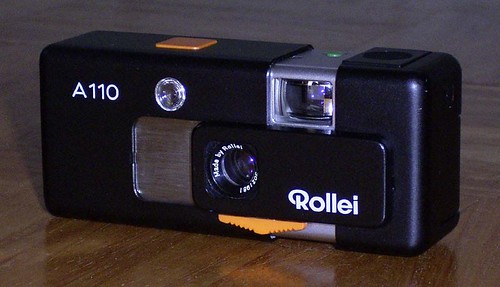Rollei A110

|
| black magic pocket camera made by Rollei |
When the Rollei A 110 appeared on the market it was advertised as the smallest pocket camera of the world. Concerning the new pocket film standard of the 1970ies, the type No. 110 film cartridges it was really the smallest serious camera construction. Heinz Waaske's camera construction team needed 2 years from construction to mass production. In 1974 the prototype of the A 110 was a sensation at the camera fair "photokina" since it was smaller than the cardboard boxes in which the single pocket films were sold. But mass production was delayed until late 1975. The efforts needed to make that miniature camera consisting of 260 parts in a good quality were time consuming. The camera entered the market high-priced. 1978, before its production was moved from Braunschweig to Singapore, it had already reached a lower price level, 348 DM.
The camera had a typical 110 film camera design: it had to be pulled open. When it was closed important parts like lens and viewfinder were covered by the two outer parts of the camera body. So this pocket camera could really be carried in the pocket when it was closed. The difference to the average pocket camera was the use of mainly metal parts for its construction. And some of the few plastic parts were made of the durable Delrin. This choice of quality materials was necessary for reaching the high level of miniaturization.
A great innovation was the camera's shutter. Its blades were open before exposure. Instead the aperture blades were shut before exposure. The moment of exposure began with the opening of the aperture blades, and ended with shutting the shutter blades. Shutter speed control was not less exciting in that camera: the CdS-photo-diode had own aperture blades which opened simultaneously to the ones of the lens. Both apertures were driven by the same mechanical element. During the meantime between aperture opening and shutter shutting the lense's aperture blades were kept in position with an electric magnet.
Despite of its wide-angle lens it had a distance selector, controllable by distance symbols shown in the viewfinder.
specifications
- Type: pocket camera
- Manufacturer: Rollei (1975-1978 in Braunschweig (124.000 units), 1978-1981 in Singapore (72.000 units))
- Year of launch: 1974
- Film: Type No. 110 cartridges for 16mm film with speeds 64 to 500 ASA
- Lens: Rollei Tessar 1:2.8/23mm
- Shutter: electronically controlled Rollei-Prontor leaf shutter
- Exposure: fast silicium photo diode measures light for program-controlled exposure with shutter-speed/aperture combinations from 1:2.8 - 4sec. to 1:16 - 1/400 sec.
- Dimensions: 84×44×30mm (closed, length 100 mm when opened)
- Weight: 185 g with battery